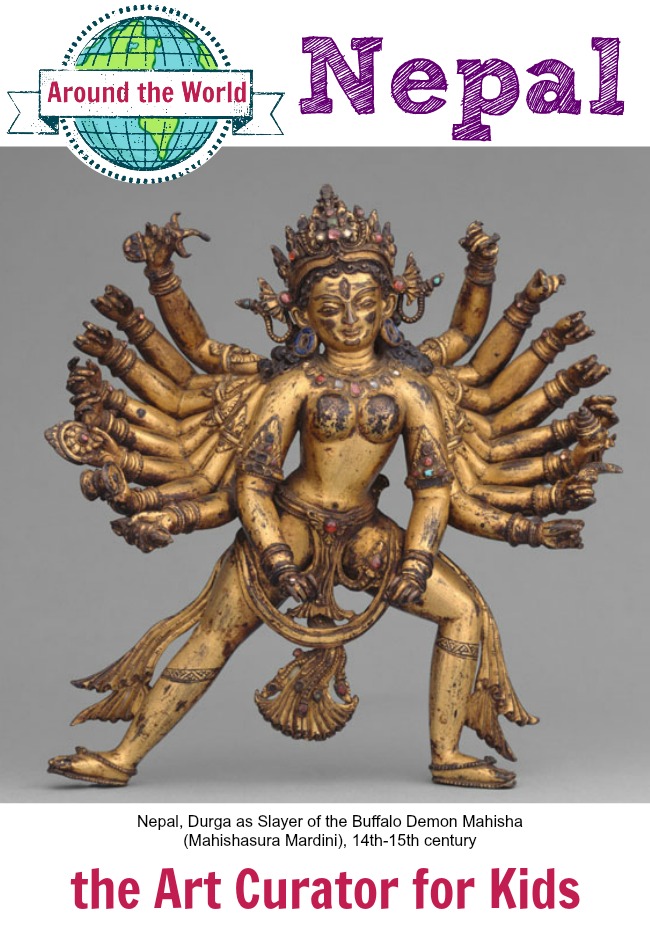It’s time to visit Nepal on our trip of world art for a Hindu sculpture lesson from Nepal.

This special lady is Durga, a fierce Hindu goddess, created by a group of male Hindu deities who had all been defeated by the demon Mahisha. They created her in order to beat Mahisha who had turned himself into a fearsome, powerful buffalo. Each of the deities gave her a weapon, and you can see she holds several weapons in many of her 18 hands. In the story, she defeats Mahisha and “liberated the universe from darkness” (Source: Met Museum).
This sculpture is missing a component. It was originally on a pedestal where she trampled Mahisha under one foot in an ultimate display of good versus evil. (That might be a good conversation to have with the older students. How does an artwork change when you take it out of context and put it in a museum.)
Here are some views of Durga in other artworks. How is this artwork from Nepal different than the others? Artists in Nepal had the tendency to heavily embellish their art. Notice all of the added gold and jewels in this artwork. (Source: Met Museum Bulletin )
[slideshow_deploy id=’2437′]
Durga is an important deity in the Hindu religion, and she has an annual festival celebrating her called either Durga Puja or Durgotsava. During these festivals, sculptures depicting Durga’s story are displayed and worshipers place flowers on and around the scene. You can see a couple of these sculptures in the above slideshow and a lot more pictures on Wikipedia.
Hindu Sculpture Discussion Questions
- What’s going on in this sculpture? What do you see that makes you say that?
- Make a list of words that describe Durga based on what you see in the story.
- Compare and contrast this artwork to the dance in the video above.
- Why does Durga have many arms? What is she doing with her hands?
Storytelling through Dance Art Learning Activity
Have students work together to create a dance about a story or person who is important to them. How can they tell the story without using words? How does the music contribute to the story? How do the expressions and gestures help tell the story?
Hindu Sculpture Lesson Resources and Citations
I’ve done Hindu sculpture lessons in a couple other posts as well. Check out these:
- 5 Artworks your Children will Love–Shiva Nataraja dances atop Apasmaru, a demon of ignorance and temptation
- Art Around the World – India–The Meenakshi Amman temple in India holds 33,000 sculptures in/on it! Amazing!
Here are some more great Hindu art lesson plans from around the web:
- Be a Vishnu Avatar, another great Hindu sculpture lesson incoporating dance from the Art Institute of Chicago
- Rubin Museum of Art, Animal Symbolism (link to pdf is under “Lesson Theme Examples”)
- A Lesson Plan from the Met Museum comparing Buddhist and Hindu art
Works Cited:
“The Arts of South and Southeast Asia”: The Metropolitan Museum of Art Bulletin, v. 51, no. 4 (Spring, 1994) (1994)
That’s it! Thanks for reading. I’d love to hear your thoughts about the artwork in the comments.
Click here to find more art from around the world, and come back tomorrow for a trip to Mexico to enjoy an Olmec sculpture! Remember you can get the whole month of Art Around the World posts as a PDF eBook in the Curated Connections Library!





Leave a Comment